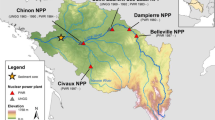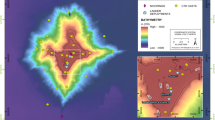Abstract
The deposition and possible mobility of plutonium in sediments contaminated by nuclear fuel reprocessing wastes are of considerable importance in assessing the short- and long-term fate of this pollutant. Previous studies have shown that marine sediments very effectively and quickly remove plutonium1, and have suggested both immobile2 and mobile2,3 behaviour of plutonium after deposition. Here, the deposition characteristics and lack of vertical migration of plutonium isotopes in intertidal sediments of the Irish Sea, which are contaminated with radioactive wastes from the Windscale reprocessing facility, are discussed.
This is a preview of subscription content, access via your institution
Access options
Subscribe to this journal
Receive 51 print issues and online access
$199.00 per year
only $3.90 per issue
Buy this article
- Purchase on Springer Link
- Instant access to full article PDF
Prices may be subject to local taxes which are calculated during checkout
Similar content being viewed by others
References
Hetherington, J. A. in Environmental Toxicity of Aquatic Radionuclides: Models and Mechanisms 81–106 (Ann Arbor, Michigan, 1976).
Livingston, H. D. & Bowen, V. T. in Environmental Toxicity of Aquatic Radionuclides: Models and Mechanisms, 107–130 (Ann Arbor, Michigan, 1976).
Livingston, H. D. & Bowen, V. T. Earth planet. Sci Lett. 43, 29–45 (1979).
Lerman, A. in Proc. 3rd natn. Symp. Radioecol. NTIS, Springfield, Virginia, 936–944 (1971).
Aston, S. R. & Stanners, D. A. Estuar. Coastal mar. Sci. 9, 529–541 (1979).
Hetherington, J. A. Mar. Sci. Commun. 4, 239–274 (1978).
Hetherington, J. A. & Jefferies, D. F. Neth. J. Sea. Res. 8, 319–338 (1974).
Talvitie, N. A. Analyt. Chem. 44, 280–283 (1972).
British Nuclear Fuels Ltd, Annual Report on Radioactive Discharges and Monitoring of the Environment (BNFL, Risley, 1978. 1979).
Stanners, D. A. & Aston, S. R. Estuar. Coastal mar. Sci. (in the press).
Hetherington, J. A., Jefferies, D. F., Mitchell, N. T., Pentreath, R. J. & Woodhead, D. S. in Transuranium Nuclides in the Marine Environment, 139–153 (IAEA, Vienna, 1976).
Robbins, J. A., Krezoski, J. R. & Mozley, S. C. Earth planet. Sci. Lett. 36, 325–333 (1977).
Aller, R. C. thesis, Yale Univ. (1977).
Aston, S. R. Mar. Chem. 8, 319–325 (1980).
Nelson, D. M. & Lovett, M. B. Nature 276, 599–601 (1978).
Chester, R. & Hughes, M. J. Chem. Geol. 2, 249–262 (1967).
Alberts, J. J., Muller, R. N. & Orlandini, J. A. in Radiological and Environmental Research Division A. Rep. ANL-76-88 Part III (Argonne National Laboratory, 1976).
Author information
Authors and Affiliations
Rights and permissions
About this article
Cite this article
Aston, S., Stanners, D. Plutonium transport to and deposition and immobility in Irish Sea intertidal sediments. Nature 289, 581–582 (1981). https://doi.org/10.1038/289581a0
Received:
Accepted:
Issue Date:
DOI: https://doi.org/10.1038/289581a0
This article is cited by
-
Plutonium in Soils from Northeast China and Its Potential Application for Evaluation of Soil Erosion
Scientific Reports (2013)
-
Evidence for the remobilisation of transuranic elements in the terrestrial environment
Environmental Geochemistry and Health (1993)
-
Distribution and behaviour of99Tc,237Np,239,240Pu, and241Am in the coastal and estuarine sediments of the Irish Sea
Journal of Radioanalytical and Nuclear Chemistry Articles (1992)
-
Plutonium redistribution by biological activity in Irish Sea sediments
Nature (1983)
-
Radiocaesium and plutonium in intertidal sediments from southern Scotland
Nature (1982)
Comments
By submitting a comment you agree to abide by our Terms and Community Guidelines. If you find something abusive or that does not comply with our terms or guidelines please flag it as inappropriate.



